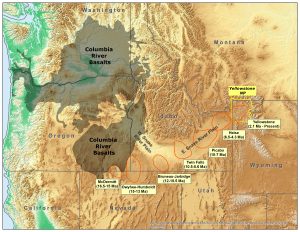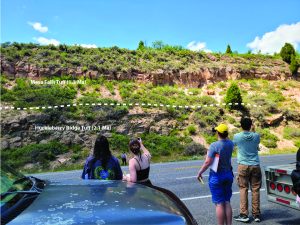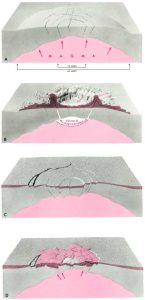Chapter 13 Volcanism
13.5 Yellowstone Eruptive History and the Typical Eruptions Sequence
Hot spot volcanism is responsible for Yellowstone eruptions
Yellowstone’s volcanism is the most recent in a 17 million-year history of volcanic activity that progressed from southwest to northeast along the Snake River Plain (Figure 13.5.1). A track of volcanic complexes can be traced for more than 750 km (450 mi) and marks the surface manifestation of hot spot volcanism where a plume of mantle material rises into the crust, is stored, then erupts. Similar to today’s Yellowstone Plateau Volcanic Field, at least six other large volcanic centers along this path generated multiple caldera-forming eruptions. The calderas are no longer visible because they are buried beneath younger basaltic lava flows and sediments that blanket the Snake River Plain. Eruptions from each of the volcanic centers lasted a few million years before crustal movement reoriented the center of magmatic activity. There was a 2.3-million-year hiatus between the last significant caldera-forming event in the adjacent and older Heise Volcanic Field, and the inception of volcanic activity in the modern Yellowstone Plateau.

The Yellowstone Plateau Volcanic Field
Three extraordinarily large explosive eruptions in the past 2.1 million years each created a giant caldera within or west of Yellowstone National Park. During these eruptions, enormous volumes of hot, fragmented volcanic rocks spread outward as pyroclastic density currents over vast areas (Figure 13.5.2).

The hot ash, pumice, and other rock fragments accumulated and welded together to form extensive sheets of hard lava-like rock. In some sections, these welded ash-flow tuffs are more than 400 m thick! These ash-flow sheets—from oldest to youngest, the Huckleberry Ridge, Mesa Falls, and Lava Creek Tuffs—account for more than half the material erupted from Yellowstone in the past 2.1 million years (Figure 13.5.3).
Because such enormous amounts of magma were erupted during each explosive event, the roof of the magma-storage regions collapsed, and the ground above subsided by many hundreds of meters to form the calderas.
| Caldera-forming ash flow tuff | Age
(millions of years ago) |
Volume erupted
(km3) |
Area Covered (km2) | Caldera dimensions (km) | Caldera name |
| Lava Creek Tuff | 0.640 | 1,000 | 7,500 | 85 x 45 | Yellowstone caldera |
| Mesa Falls Tuff | 1.3 | 280 | 2,700 | 16 km in diameter | Henry’s Fork caldera |
| Huckleberry Ridge Tuff | 2.1 | 2,450 | 15,500 | 75-95 x 40-60* | Big Bend Ridge, Snake River, and Red Mountains caldera segments |
*Inferred first-cycle caldera boundary is irregular; caldera consists of three overlapping collapse areas

Typical Yellowstone Eruption Sequence
Volcanic rock deposits from eruptions in the Yellowstone Plateau Volcanic Field reveal that a typical sequence occurs as the magma storage region evolves. Caldera forming events are the most known and talked about, but lava flows both precede and follow the massive explosive eruptions. Before and after these caldera-forming events, eruptions in the Yellowstone area produced rhyolitic and basaltic rocks—large rhyolite lava flows and some smaller pyroclastic flows in and near where the calderas collapsed and basalt lava flows around the margins of the calderas. Large volume rhyolitic lava flows (approximately 600 km3 (144 mi3) were erupted in the caldera between 180,000 and 70,000 years ago, distributed primarily along two north-south alignments of vents.
Repeat events in the evolution of Yellowstone shows the caldera system follows a typical volcanic cycle (Figure 13.5.4):

- Slow uplift occurs over a broad area (larger than that of the future caldera). This uplift reflects the development of a magma storage region within the Earth’s crust several kilometers below the surface. As the North American tectonic plate moves to the southwest, lesser evolved (basalt) magma within the Yellowstone hotspot rises, interacts with, and stalls within the dense crust. The stalled magma interacts with surrounding rock, cools, and evolves into a rhyolite; all the while, the hotspot continues to feed magma from deep within the Earth. Stretching of the crust above the inflating magma chamber leads to concentric and radial (“ring”) fracturing and faulting at the surface, typically accompanied by the extrusion of basalt and rhyolite lavaflows from these fractures.
- During the evolution of the magma chamber, excess pressure builds up within the system. At a critical stage in enormous volumes of rhyolite magma erupt explosively through the ring-fracture zone that was created during inflation and uplift. Massive quantities of tephra and pyroclastic density currents produce extensive ash-flow sheets (ignimbrite deposits). As the eruptions progressively empties the storage region of its magma, the roof of the magma chamber collapses along the same ring fractures to produce a large caldera.
- After collapse, rhyolite lava flows and smaller explosive eruptions occur within or adjacent to the caldera. Shortly following collapse, the caldera floor may be uplifted by hundreds of meters (feet) in a process known as resurgent doming. This uplift reflects renewed pressure as magma rises again into the magma chamber. Magma rises from the hotspot and stalls beneath the larger rhyolite magma storage region, but some finds its way to the surface along its edges and erupts as plateau-margin basalt lava flows. Hydrothermal activity (such as hot springs and geysers) occurs during all three stages but, in the third stage, it becomes the dominant (or only visible) sign at the surface of magmatic activity below.
In the present-day Yellowstone caldera, lakes formed where streams draining into or along the margin of the caldera were dammed by these thick intra-caldera rhyolite flows, including Shoshone, Lewis, Heart, and Yellowstone Lakes.
Research indicates that rhyolite lava flows and caldera-forming ignimbrite tuffs were fed from a magma storage region located a 5-8 kilometers deep. Magma formed from the melting of rocks in the lower-continental crust below Yellowstone. These rocks melt because Yellowstone resides upon a hotspot, or a plume from the mantle that is hot and upwelling buoyantly. As a result, heat to melt continental rocks is supplied by repeated injections of basalt magma from the mantle into the shallow crust.
Eruptions will occur again from the Yellowstone Plateau, but they may not be very large
The long-term nature of volcanism in this part of North America suggests that more eruptions will occur as the Yellowstone Plateau continues to evolve. The most recent series of eruptions, 160,000 to 70,000 years ago, extruded more than 20 thick rhyolite lava flows and domes, most of them within the youngest caldera. Other post-caldera lavas are basalts, erupted around the margins of the rhyolitic calderas. Based on Yellowstone’s history, the next eruptions are likely to expel lavas, which might be either rhyolites or basalts, possibly accompanied by moderate explosive activity. Far less likely would be another enormous outpouring of material that could lead to a fourth caldera.
Media attributions
- Summary of Yellowstone Eruption History, USGS, Public Domain, Remixed by Ryan B. Anderson
- Geologic Research Reveals Typical Eruption Sequence, USGS, Public Domain, Remixed by Ryan B. Anderson
- Formation of the Yellowstone Caldera, USGS Bulletin 1347, Public Domain, Remixed by Ryan B. Anderson
- Figure 13.5.1, USGS, Public Domain
- Figure 13.5.2 © Ryan B. Anderson. CC BY
- Figure 13.5.3, USGS, Public Domain
- Figure 13.5.4, USGS, Public Domain
